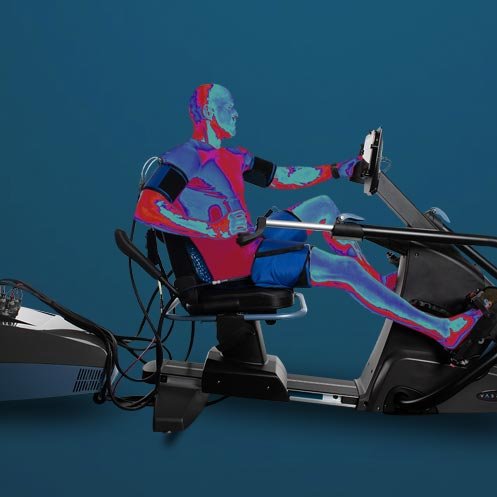
The health benefits from Vasper are numerous and broad. A wide spectrum of clients has taught us that Vasper can be used to alleviate symptoms and provide support for a number of diseases and conditions. Vasper partnered with top hospitals and clinics to investigate the potential benefits of Vasper use in different clinical settings. Though the specific mechanisms for how Vasper helps the body are still being investigated, many studies have shown that Vasper is not only for health and performance improvement but can also help with a multitude of illnesses and conditions.
Science behind Vasper
Vasper’s mission is to provide non-invasive technology solutions that allow people, even with a variety of health conditions, to actively and safely engage their body’s natural systems in achieving optimal health, balance and wellness.
Below are research studies on the use of Vasper by people with a variety of health conditions, such as Cardiac Rehabilitation, Diabetes, Concussions and Post-Concussive Syndrome, Parkinson’s, Balance and PTSD. Vitality for Life is Parkinson Wise certified by PANC (Parkinson Association of Northern California) to work effectively with the Parkinson’s community.
VASPER FOR CARDIAC REHABILITATION
WISE VASPER SAFETY STUDY
Before starting a clinical trial in cardiac rehabilitation, cardiologist Dr. Jeff Gladden wished to demonstrate Vasper’s safety in using low-pressure blood flow restriction on a moderate exercise platform.
In this study, heart rates and blood pressure values were measured across 7 sessions with varying leg pressures applied – from 0mmHg to 85mmHg.
There was no significant difference in heart rate or blood pressure when comparing these sessions with blood flow restriction to a session without the Vasper cooling cuffs. This study demonstrates with the proper medical oversight and training, Vasper can be safe for almost any population.
VASPER FOR CARDIAC REHABILITATION
WISE VASPER SAFETY STUDY
Before starting a clinical trial in cardiac rehabilitation, cardiologist Dr. Jeff Gladden wished to demonstrate Vasper’s safety in using low-pressure blood flow restriction on a moderate exercise platform.
In this study, heart rates and blood pressure values were measured across 7 sessions with varying leg pressures applied – from 0mmHg to 85mmHg.
There was no significant difference in heart rate or blood pressure when comparing these sessions with blood flow restriction to a session without the Vasper cooling cuffs. This study demonstrates with the proper medical oversight and training, Vasper can be safe for almost any population.
Gladden J, Wernecke C, Rector S, Tecson K, McCullough P.
Pilot Safety Study: The Use of Vasper, A Novel Blood Flow Restriction Exercise, In Healthy Adults.
VASPER AND DIABETES
CONVENANT MEDICAL TYPE II DIABETES STUDY
Covenant Medical Hospital has a large population of patients with Type Ii Diabetes, and saw the potential for Vasper to alleviate exercise difficulties and improve results for people with Type II Diabetes.
Type II Diabetics face many challenges in improving their health, including that the most effective exercise routines are typically higher-intensity but also can result in issues with joint loading and pain, blood sugar management, and can be inaccessible due to common comorbidities.
In this study, patients used Vasper for 1-2 times a week over a period of 6 months. The midpoint (3 month) data indicates significant improvements in HBA1C, a marker for glucose tolerance, with an average decrease of 8%, and an average 3.6lbs of weight lost.
Vasper is an effective way to allow and adjust moderate exercise in this population while delivering results similar to the high-intensity programs. This data was accepted for abstract and poster presentation at the 2019 American College of Sports Medicine Annual meeting.
VASPER ON PREVENTING FALLS IN SENIORS
KAHALA NUI ELDERLY FALLS STUDY
The Kahala Nui Senior Living Home was interested in studying the potential of Vasper to help their residents prevent falls. 27 participants age 60-90 completed a 12-session program and were tested in measures of fall risk.
The average improvement to balance was 17%, the average increase in knee extension strength was 11 pounds of force, and participants showed a 6 second average improvement in the 10 Sit to Stand test.
Participants also reported a 63% improvement in subjective strength and 53% in balance. When compared to four other similar studies, the Vasper training intervention demonstrated a 260% improvement in only 13% of the training time, highlighting not only Vasper’s effectiveness in improving results, but also that these results take much less time and effort.
VASPER FOR CONCUSSION RECOVERY
2-Year IRB-approved Vasper clinical trial at the Cantu Concussion Center
The Cantu Concussion Center is one of the leading centers in the US for concussion treatment and rehabilitation. Dr. Cantu designed this study to focus on the need to help people with severe concussion symptoms and those diagnosed with Post-Concussive Syndrome.
Results: The study, published in 2019, shows that in 6 weeks of 2 Vasper sessions per week, the Vasper group showed statistically significant improvements in quality of life and measures of concussion recovery, specifically stability in emotional and sleep measures after a follow-up period of 6 weeks without rehabilitation.


